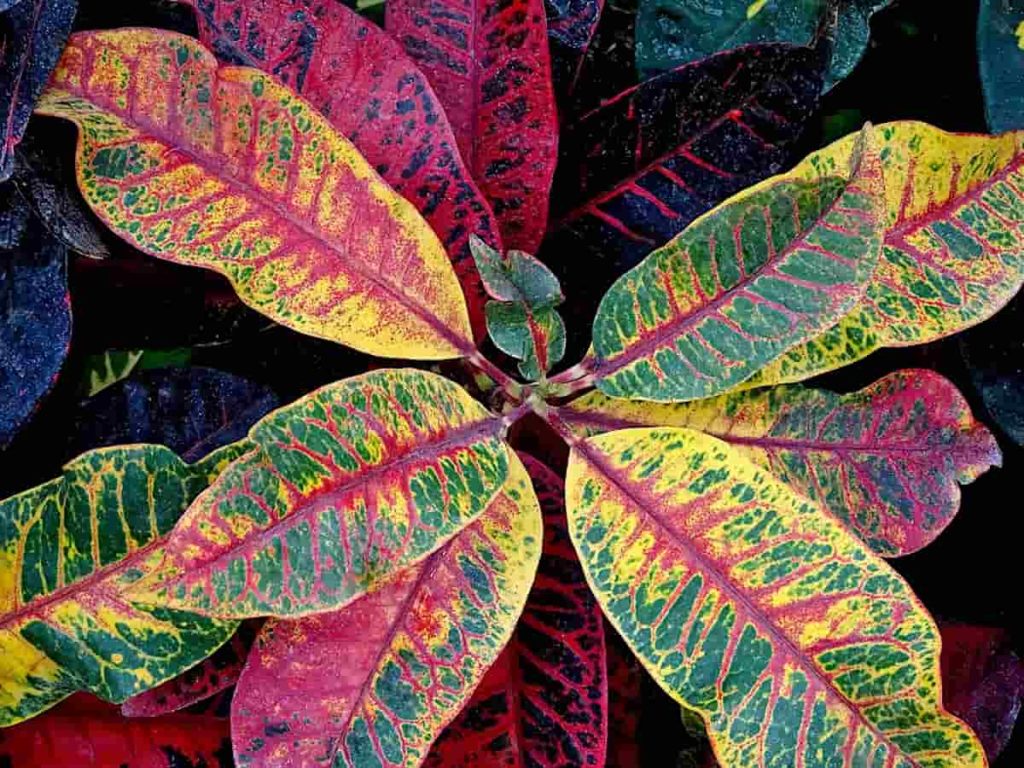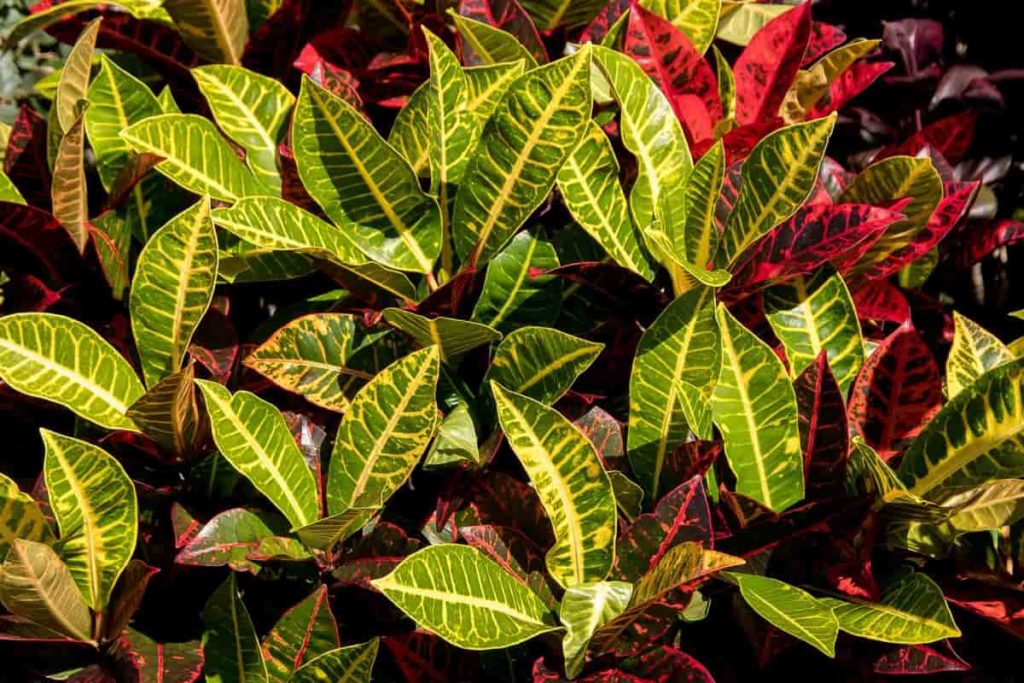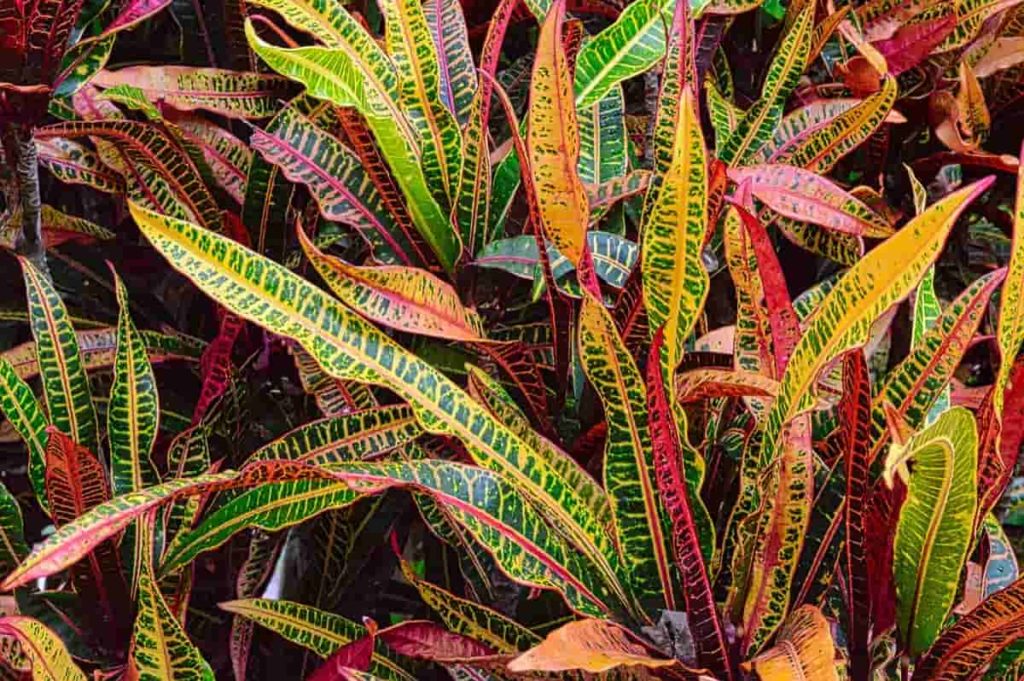Beautiful multicolored leaves and practically endless leaf varieties characterize the croton plant. They are commonly planted outside as ornamental shrubs in USDA hardiness zones 11 and 12. Crotons like damp, warm environments with dappled light and plenty of water in their natural habitat. Indoors, these plants are tough to satisfy. Let’s check out a detailed guide to growing croton plants at home.

Outdoor plants may grow up to ten feet tall, but potted examples are often considerably smaller, making them ideal for permanent plants indoors or outdoors. Croton usually grows, gaining fewer than 12 inches in height every growing season on average. When raising croton plants inside, the greatest issue is keeping the right temperature since they lose leaves if it becomes too cold. Crotons, on the other hand, are well worth the time and effort due to their vibrant color.
Croton can be cultivated at any period of the year as long as the temperature stays between 70 and 80 degrees Fahrenheit, whether indoors, outdoors, or in a greenhouse. The more direct sunshine a Croton receives, the more vibrant its leaves become. New leaves can develop with more green color if they are in a location with less sunshine.
Guide to growing croton plants at home
Can you grow croton plants indoors?
Croton plants can be grown in pots and maintained indoors, but they need to be placed in an area that gets enough sunshine. The croton’s colors will diminish in the absence of light. In the scenario of a dry interior climate, a humidifier can be beneficial for indoor croton. When grown inside, the plant is prone to becoming dusty. If this occurs, you may either spray the plant outside or use a moist sponge to eliminate any dust or bug residue.
In case you miss this: Growing Croton Plants – Indoors, Outdoors, Balcony, Terrace, Backyard From Cuttings At Home

Can you grow croton plants outdoors?
When caring for outdoor croton, it’s a good idea to cover the plant if it’s in the ground. It’s important to note that they are tropical species that aren’t adapted to cold conditions, which can harm the leaves and even the roots. Because croton hardiness is restricted to temperatures below freezing and even somewhat above, northern gardeners should only try to grow the plant outside during the hottest days of summer. To keep the leaf hues vibrant, place the plant in a location that receives lots of bright yet indirect light.
How to plant croton plants?
Croton plants thrive on soil that drains well while still retaining enough moisture to support their development. The plant may develop root rot if the growth media retains too much water. Keep in mind while selecting a container for your croton that the plant will grow vertically, which may lead it to become top-heavy. Choose a container that won’t readily topple over as the croton grows. Alternatively, aim to gradually increase the size of your pots.
Use a potting mix that drains effectively. Croton prefers a damp but not wet environment. Croton may be cultivated outside as a distinctive and colorful landscaping plant in locations with hot, humid summers. They look great in tropical-themed containers or the ground with annuals. Croton must be brought indoors when nighttime temperatures dip below 50°F (10°C).
Choosing a site for croton plant according to sunlight
Crotons require bright, indirect light to thrive. To produce beautiful yellow, crimson, and purple leaves, these plants need 6 to 8 hours of direct sunshine every day. If it receives enough strong light, it will produce vibrant colors. The leaves will become green if the plant does not receive enough light.
In case you miss this: House Plants Care, Tips, Ideas, and Techniques

Choose a bright, draft-free location with a south, west, or southwest orientation that is always over 60 degrees. If you don’t have enough natural light, consider using a grow light, such as LED bulbs. Plants that do not receive enough sunshine are less vibrant.
How much water does the croton plant need?
During the growth season, you’ll have to water your croton plants often. They demand continuous moisture in the soil, therefore if the top of the plant feels dry, it should be watered again. Furthermore, these plants like a humid atmosphere. If you can’t find a spot with this sort of environment, you may create it intentionally by misting the leaves. Watering requirements will reduce throughout the winter months, so be sure that you do not overwater your plants.
Fertilizers required for croton plant
Slow-release pellets should be applied three times during the growing season: in the early spring, mid-summer, and early fall. Alternatively, every other month during the growth period, from early March to the end of September, you can apply liquid fertilizer. Because fertilizer types differ, read the package directions for feeding amounts. If you want to feed regularly, you may usually cut the package-recommended quantity by half strength.
Then, during the next month, monitor the plant’s rate of growth; based on how vigorously you need your plants to develop, you can alter and add or remove fertilizer. Fertilizer should not be used during the wintertime. Use acidifying fertilizers with ammonium nitrate, ammonium sulfate, or sulfur-coated urea, since this plant loves slightly acidic soil. 3-1-2 and 8-2-10 are the optimum NPK ratios (nitrogen-phosphorus-potassium) to aim for.
Temperature and humidity required by croton plants
Maintain a room temperature of at least 60 ℉, and keep the plant away from cold breezes. The color of the leaves is also affected by humidity and a lack of intense light. Maintain a humidity of 40 to 80 percent. The plant may shed some of its leaves if the humidity isn’t strong enough. Run a humidifier in the room or place a humidity tray under the plant and group it with other plants if you have difficulties keeping this amount of moisture in your home.
In case you miss this: Small Balcony Gardening Ideas in India, Design Tips

Pruning of croton plants
Because these plants react well to pruning, whenever your croton plant grows leggy, prune it firmly at the start of the growing season. If you wish to keep a certain form, remove any sickly leaves and branches. Remove no more than a third of the stem at a time. The severed section of the plant will regenerate. If you’re trimming an indoor plant, wait until it’s hardened off or has been progressively exposed to outdoor conditions for a week before moving it outside.
Propagation of croton plants
Croton propagation is easy; all you have to do is cut a clipping from the plant’s top and set it in the soil to take root. However, this new plant will need warmth to establish roots, so you may need to set up a greenhouse environment for it to develop. Using a plastic bag to cover the plant is one way to get this effect. Make careful to water the plant before covering it with the bag; the new plant should not require additional watering until new growth appears and the plant takes root. Seeds can be used to start new croton plants.
Are croton plants poisonous?
Crotons are potentially dangerous plants to keep in your house, especially if you have children or pets. The milky liquid found inside the plant’s stem is poisonous. The sap can induce indigestion in dogs, cats, and tiny children, although it is usually not lethal. Because ingesting the sap-filled seed pod can be dangerous, keep croton bushes away from inquisitive kids and dogs.
Croton plants offer beautiful leaves, but they might be more trouble than they’re worth. When relocated, this plant can get irritable, and its sap can harm tiny cats, dogs, or children. Make sure it’s in a spot where you can properly enjoy its beauty.
Potting and repotting of croton plant
For the first three growing seasons, every year in the spring or summer, repot young croton. Afterward, repot only when you find roots of the plants are growing out of drainage holes or at the soil line. Choose a container that has many drainage holes. It must only be one size bigger than the present container for the plant. Fill the bottom of the new container with one to two inches of moist peat-based potting soil.
Turn the croton on its side and carefully slide it out of its container to remove it from its previous container. Place it in the new pot’s middle. Potting soil should be used to fill up around the roots. Water the plant and, if necessary, add more soil to raise the soil level to one inch below the bottom of the new container.
In case you miss this: Water Growing Indoor Plants – Without Soil

Tips for successful growing of croton plants
People often bring home fresh croton from the shop, only to find that the plant has lost some of its leaves, if not, all of its leaves within days. In a nutshell, you did not fail; this is typical croton behavior. Croton plants don’t like being relocated, they become stressed and lose their leaves. As a result, it’s preferable to keep the plant as still as possible. If moving the plant is inevitable, don’t be alarmed if some leaves fall off. Simply provide regular care for the plant, and it will regenerate its leaves in a short amount of time, proving to be a hardy houseplant.
Crotons, like many other houseplants, require regular watering and humidity. Because it’s a tropical plant, it thrives in high humidity, so keeping it on a pebble tray or spraying it often can make it look its best. Croton in pots should be watered only when the top of the soil feels dry to the touch. Then, water them until the water runs out of the bottom of the container. Because it cannot handle temperatures below 60 degrees F, the plant should be maintained away from draughts and cold. The croton will lose leaves and even die if it is exposed to temperatures below this.
Common problems with crotons
Crotons are a plant that requires a lot of attention. The health of this plant will be affected by cool winds, low humidity, and bad soil or insufficient nutrients, which can attract a variety of issues, including pests, infections, and a dismal look. To keep your plant growing, try to control its surroundings as much as possible.
Dull leaf coloration
Bright light brings out the plant’s most beautiful hues, but the temperature must not be too hot. Summer in the tropics may be too much for some croton species. During a heatwave or higher temperatures, reduce or avoid fertilizer application. Extremely hot days can stress croton, resulting in greying or flat hues. Fans or air ventilation can assist chill the leaves while also preserving their health. During periods of extreme heat, keep an eye on the water level and don’t allow the plant to dry up.
In case you miss this: Vertical Gardening with Plastic Bottles for Dummies

The frequent dropping of leaves
At the first sign of chilly weather or cool draughts, crotons will lose their leaves. If your plant is in a container outside and the forecast forecasts for temperatures below 50 degrees Fahrenheit, bring it inside. Insect activity, like mites and mealybugs, can also cause leaves to fall. Look for small eggs or insects on the undersides of leaves. To get rid of the pests, scrub the leaves with pesticide soap or apply horticultural oil to the damaged regions.
Curling and rolling of leaves
When the leaves are enormous and the color is plain or rich, they might roll or twist. Reduce the amount of fertilizer you use to address this. The plant is probably growing too rapidly and will require more light to thrive. If possible, move the plant to an area with more light.
- How to Grow Hibiscus from Flower
- Plantation Ideas for Home Decoration: A Beginners Guide
- Flower Garden Designs and Layouts for Beginners
- Planting and Spacing Techniques in Papaya: A Beginner’s Guide
- Growing Gold: Essential Techniques for Planting Pineapples
- How to Make Kalanchoe Plant Bushy: Home Remedies and Solutions
- 11 Reasons Why Your Gardenia is Not Blooming: Home Remedies and Solutions
- Eco Elegance: The Guide to Designing a Drought-Tolerant Landscape
- Gardening on a Slope: Strategies for Hillside Landscaping
- Nourish and Flourish: Top Organic Mulches for Thriving House Plants
- Everything You Want to Know about Indian Mogra Flower: Discover Uses and Growing
- Green Thumb Success: Expert Tips for Cultivating Greenhouse Pumpkins All Year Round
- Maximize Growth & Flavor: The Ultimate Guide to Companion Planting in Herb Gardens
- How to Control Rhododendron Problems Naturally: Home Remedies and Organic Ways to Fix Them
- Natural Magic: The Remarkable Benefits of Cinnamon for Plants
- Best Steps to Revive Dying Tulip with Natural and Organic Treatment
- 10 Reasons Why Your Angel Trumpet is Not Blooming: Remedies and Treatment
- How to Fix Periwinkle Leaf and Flower-Related Problems: Natural Remedies and Solutions
- How to Fix Zinnias Leaf and Flower Problems: Discover Natural and Home Remedies
- Organic Steps to Induce Lemon Tree Flowers: A Comprehensive Guide
- Bloom Booster: Crafting the Perfect Homemade Bougainvillea Fertilizer
- Optimizing Growth: A Guide to Applying NPK Fertilizer for Potted Plants
- 10 Best Homemade Fertilizers for Rubber Plant: DIY Recipes and Application Method
- How to Boost Female Pumpkin Flowers: Effective Steps for More Flowers and High Yields
- Transform Your Indoor Garden: Top Benefits of Pink Salt for Houseplants
- 10 Best Homemade Fertilizers for Peacock Plants (Calathea): Easy DIY Guide
- Unlock Blooms: 9 Reasons Why Your Potted Chrysanthemum is Not Blooming
- 8 Reasons Why Your Potted Hibiscus is Not Blooming: Fix it with Simple Solutions
- Unlock Blooms: 9 Key Reasons Your Potted Frangipani Won’t Flower
- 10 Reasons Why Is My Ice Plant Not Blooming: Remedies and Treatment
- 10 Reasons Why My Potted Hydrangea Not Blooming: Treatment and Remedies
- 10 Reasons Why is My Wisteria Not Blooming: Remedies and Treatment
- 10 Reasons Why is My Goldfish Plant Not Blooming: Remedies and Treatment
- Maximize Your Space: Ultimate Guide to Balcony Gardening with Grow Bags
- 10 Reasons Why Your Iris is Not Blooming: Remedies and Treatment
- 10 Reasons Why Your Anthurium Plant is Not Blooming: Treatment and Remedies